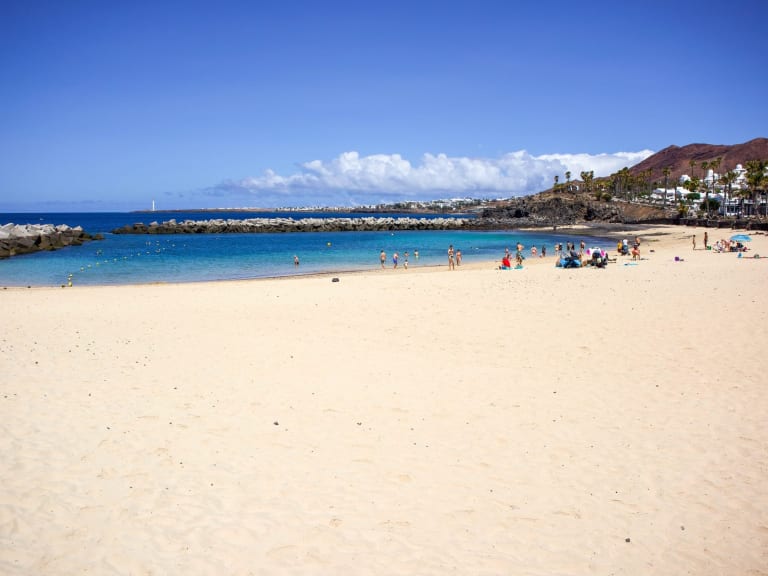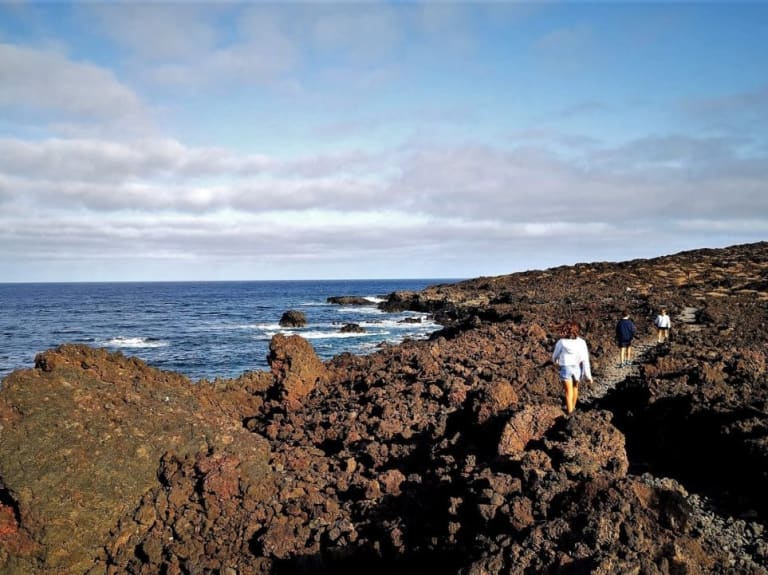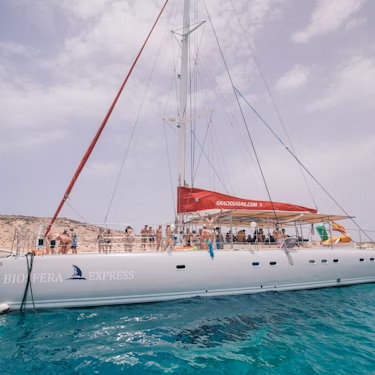More about: 5 Best Hikes in Lanzarote
At the north-eastern tip of the Canary Islands, the island of Lanzarote stands as one of the most important in the Canary archipelago. Like all the Canary Islands, there are many things to see and do in Lanzarote, including hiking, as it is a volcanic island with a very complicated topography that is ideal for hiking activities. A lot of ups and downs, as well as some lovely landscapes is what awaits you in Lanzarote.
It doesn't matter if you have too much or too little experience; in Lanzarote there are routes of all levels of difficulty, so you won't be able to turn down all the options. Near the sea, up the mountains, with plenty of exercise and also with plenty of relaxation: the hiking trails in Lanzarote are truly phenomenal. Are you up for it?
1. Lanzarote in the southeast: from Quemada beach to Blanca beach

Lanzarote is an oval-shaped island with flattened points. When viewed on a map, as is the case with almost the entire Canary archipelago, many people think that it would be perfect to walk around the island. Although this is technically possible, we are talking about nearly 200 kilometres, so I suggest you do it in sections, starting with the section in the southeast between Playa Quemada and Playa Blanca, bordering the Los Ajaches Natural Monument, a protected area with conservation regulations.
That is a route of about 21 kilometres and its difficulty is moderate, because, although there are no major ups and downs, the sun is inclement and it is not short. Furthermore, although most of the time the route is properly demarcated, it occasionally weaves its way along the coast. If you go on your own, I recommend swimming at the different beaches you will see, such as Pozo, La Casa and Papagayo beaches. You will also find the wells of San Marcial de Rubicón and its archaeological site very attractive.
Just before reaching Playa Blanca, you will come across the Castillo de las Coloradas. On the beach, I recommend you sit down to eat at a seafood restaurant or check out all the options you have for some of the best boat tours from here. As the tour is not always marked out, I advise you to do it in a group.
Practical information
- Difficulty level: Moderate
- Length: about 21 kilometres
- How the route is: most of the sections are marked, but when you enter the beaches this is lost, so it is not recommended for groups of beginners without a guide.
- Advantages of this option: you will be able to pass several beaches and go swimming in them.
- Disadvantages of this option: it is a very long route with a rather irregular route.
2. From Quemada beach to the capital

When you arrive at Quemada beach you will realise that it is one of the most fantastic places on the island. It is a practically virgin beach , with a very dark, earth-like colour and only a few white houses around. If you took the coastal route, this beach is halfway between Playa Blanca, at the southern end, and Arrecife, the capital, so today I suggest you go from Playa Quemada to Arrecife, a town well worth visiting.
In total, it's about 20 kilometres along the coast. Although it is quite a long route, the truth is that the complexity is very low, because it is done along the entire coast without any major irregularities. What you do have to be careful of is that the tide is calm, because if there is a strong tide, the route along the beaches can be tortuous. You'll pass the best beaches on Lanzarote, as well as Puerto del Carmen, Puerto Calero and following the sea path, you'll be in Arrecife in about five hours.
Depending on the time of day you go, I suggest wearing a long-sleeved shirt to protect you from the sun and taking plenty of water and food, because it's a fairly inhospitable route.
Practical information
- Difficulty level: Low
- Length: about 20 kilometres
- What the route is like: the route follows the coastline, so there is no need for a marker. It is important to be aware of the tide.
- Advantages of this option: you will be totally disconnected from the hustle and bustle of the city.
- Disadvantages of this option: the route is long and the areas through which it passes are very inhospitable.
Traveller tip
On treks like this one, the sun can be harsh. That's why you need to have plenty of sunscreen and even an umbrella to try to protect yourself. Remember that this is an excursion to an inhospitable place, so be prepared to keep walking.
3. Timanfaya Coastal Tour

On the west side of Lanzarote is the Timanfaya National Park, one of the most important in Spain, which preserves the volcanic origin of the island, with more than 25 volcanoes. Behind this chain of volcanoes there is a small coastal strip that is worth walking from one end to the other.
This trail is easy to walk, because it is about 5 kilometres long and not very steep. It is the only permitted trail within the national park that can be done without a guide. In general, you start from El Golfo, where there are different hostels and where you can buy food. Once you are there, walk north to El Paso, a great beach where you can spend the rest of the day.
Bear in mind that you are in a national park, so you will have to carry any waste with you. It's also a totally protected environment, so you'll find very basic commerce. This is a perfect trail for tourists who want to disconnect and watch the sunset because the sun sets right in front of this coast.
Practical information
- Difficulty level: Low
- Length: about 5 kilometres
- What the trail is like: there is demarcation of the national park's own trail. The route requires good shoes and protection from the sun.
- Advantages of this option: you will be able to get to know a coastline in excellent environmental preservation.
- Disadvantages of this option: the route is short and has no major landmarks.
4. To the north, between Costa Teguise and Arrieta

Although the south of Lanzarote always gets all the attention, the north coast also has many attractions and even more so if you walk along the coast between Costa Teguise and Arrieta. I suggest that you go to Costa Teguise, a very popular place which is the southern end of this route and from there you start walking for about four hours until you reach Arrieta, very close to Punta Mujeres.
To get to Teguise, you can take buses from Arrecife and you can also return there from Arrieta, so it won't be a big problem. My advice is to take this route at sunrise, so that you can see the sun rising on your right and saying good morning to you.
This trail is quite well marked and you don't walk directly along the coast but on the side, because this area of the island has a large number of cliffs, although the slopes are not complicated. Bear in mind that, apart from Los Cocoteros, there is no major population in this area, so the trail is quite isolated. Take everything you need on the trail.
Practical information
- Levelof difficulty: Moderate
- Length: approximately 18 kilometres
- What the route is like: the route is marked out and is close to the coast, but not on it. The cliffs are very close and you can make stops for the beaches.
- Advantages of this option: you can arrive and leave by public transport.
- Disadvantages of this option: the cliffs can take you a bit further away from the coast.
5. Circular route in the crater of the volcano

We are still doing one of the best tours in Timanfaya National Park, but now quite far away from the coast. Are you up for a hike on top of a volcano? Don't worry, it's quite safe. The Caldera de los Cuervos is a volcano crater with extremely arid vegetation located within this national park and it is possible to get close to the rim and even descend into the crater.
In total, the trail around the crater is no more than 4 kilometres long. The most difficult part is the ascent up the mountain, but it is a fairly quiet straight stretch and after that it is a very contemplative walk. Due to its ease, it is a route that the whole family can do and if you are looking for activities to do with children in Lanzarote, then you can include it in your list.
The car park is quite close and in total, the whole excursion can take about an hour and a half, so it is a short route that will allow you to do other things during the day. You have to be careful on the way because the wind is extremely strong, but it's the perfect place to take all the pictures you want.
Practical information
- Difficulty level: Easy
- Length: just over 4 kilometres.
- How to get there: very easy, you just have to climb up to the crater and go around it.
- Advantages of this option: you have the opportunity to get to know the crater of a volcano up close.
- Disadvantages of this option: it is a short hike, so you will have to fill your schedule with other things.
How long are the hiking tours in Lanzarote?

The great thing about hiking in Lanzarote is that there are all kinds of options on the island for different routes, so the duration will vary according to your routine. There are professional hikers who even take on the challenge of walking around the island, but in general you can take long routes, lasting seven or eight hours, as well as short ones that can last little more than an hour.
It is important that you don't let yourself get carried away and also calculate the distances. For example, a 20-kilometre journey may take seven hours, but it will also take you from one point to another, so you will have to calculate the time it will take you to get back to your hotel according to the means of transport you use and, if necessary, your budget. For this, I recommend the Intercity Bus, which is a network of public buses, or guaguas as they are known in the Canary Islands.
You should also bear in mind that, if you go in a group, the duration will be that of the group. Although the group has a pace to which many end up adapting, in this case it is important to know that, if you are faster or slower, you will have to adapt and be comfortable throughout the tour, which means being patient with the slower ones and that the faster ones should wait a bit.
What will I see on these hiking routes?

Lanzarote is a really beautiful island, because it mixes the most arid of the mountains and the most crystalline beaches. It's an island that goes from rustic to pure and when you walk the different hiking trails, you'll realise what it all entails. Many of the routes run alongside the sea, so you'll always have one eye on the ocean and the other on the island's land.
However, there's plenty more to see. And the scenery changes quite a lot. For example, on the route between Playa Quemada and Arrecife, you will notice how the landscape is extremely arid, almost desert-like, and the coastline becomes rocky and dark. For this reason, Lanzarote has been compared to the surface of Mars. But when you go to the north of the island or Playa Blanca in the south, you will see how the sea becomes even more peaceful and the vegetation is a little greener.
And what about the parks? Timanfaya is the most important one, where you can walk in a succession of volcanic craters that make up a truly unique landscape. All this makes Lanzarote a diverse destination for holidays and especially for walking, because there will always be different things to admire.
What are the advantages of hiring a guide for hiking vs. doing it on my own?

A common question among people who are new to hiking is whether they can hike alone, with their family, or if they should hire a guide. The truth is that it all depends, but there are always options in between. My advice is that, if you feel comfortable and if the path is demarcated, then there will be no problem in going on your own, as long as you carry a GPS or at least a compass that you know how to use in case of emergency.
The problem arises on paths that are not fully demarcated or that mix too much with the coastline. In this case, getting lost can be easy, so going with an experienced guide or someone who has already done the route is necessary. The guides can provide you with the best information about the route you are doing and therefore give you added value, as you will not only be exercising but also getting to know the details of the area.
There are also intermediate options, as in Lanzarote there are groups of hikers who will be happy to welcome you and with whom you can join their agenda, even if you are only going for a few days. In this case, the costs are considerably reduced and you don't need a guide to successfully reach the final destination of your chosen route.
Comparison of the different options
- Lanzarote southeast: from Quemada to Blanca beach
- Difficulty level: moderate
- Length: about 21 kilometres
- What the route is like: most of the stretches are marked out, but this becomes less pronounced on the coasts.
- From Quemada beach to the capital
- Difficulty level: low
- Length: about 20 kilometres
- What the route is like: it follows the coastline, so there will be no need for demarcation.
- Route along the Timanfaya coastline
- Level of difficulty: low
- Length: about 5 kilometres
- How the path is: there are demarcations on the National Park's own path.
- To the north, along the Costa Teguise-Arrieta coastline
- Level of difficulty: moderate
- Length: approximately 18 kilometres
- How the route is: the route is marked and is close to the coast, but not on the coast, but on the side of the cliffs.
- Circular route in the crater of the volcano.
- Difficulty level: easy
- Length: just over 4 kilometres
- How the route is: very easy, you just have to climb up to the crater and go around it.















